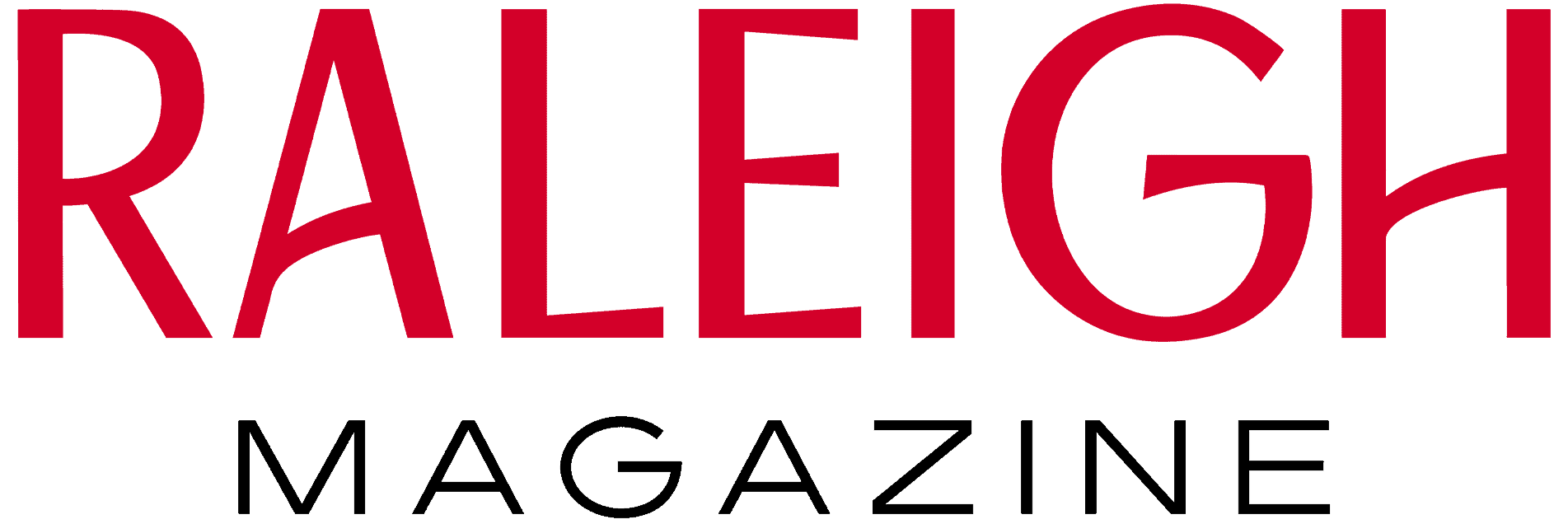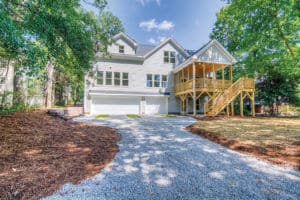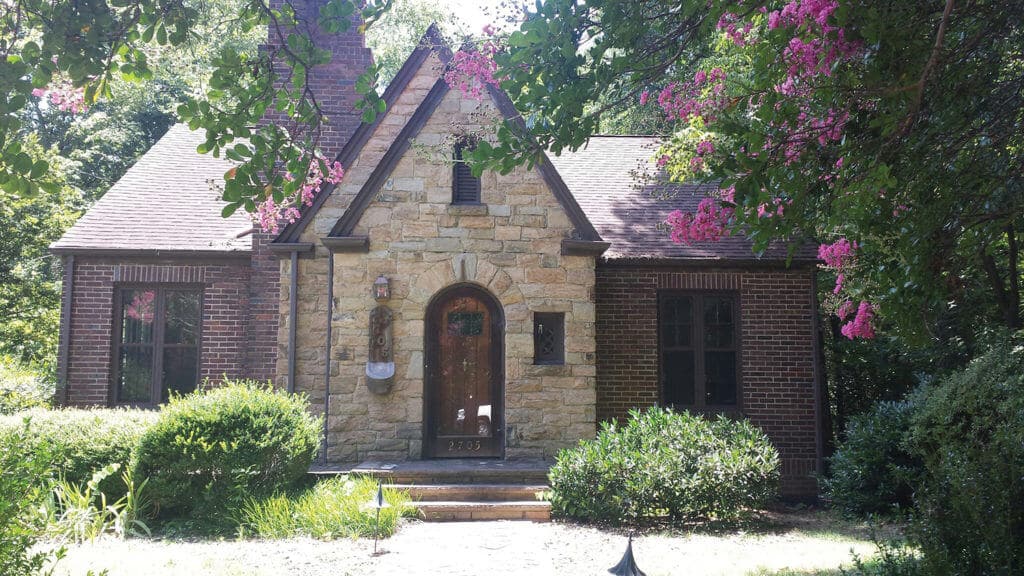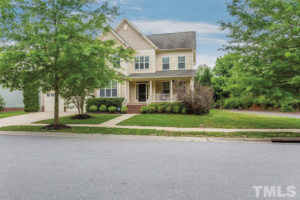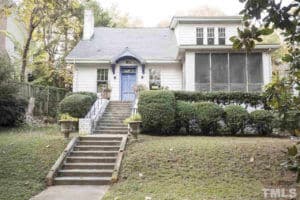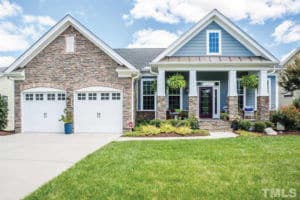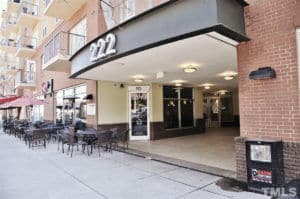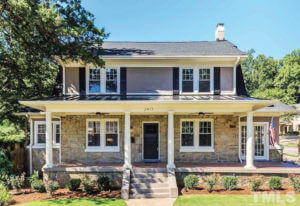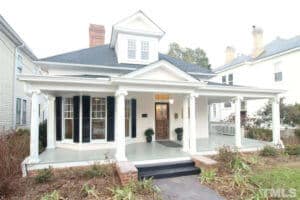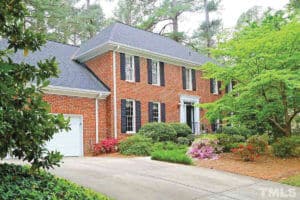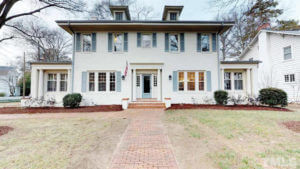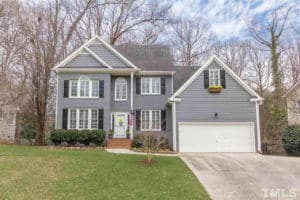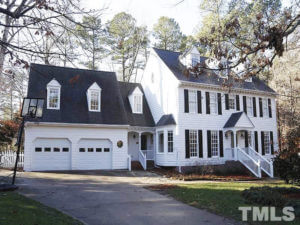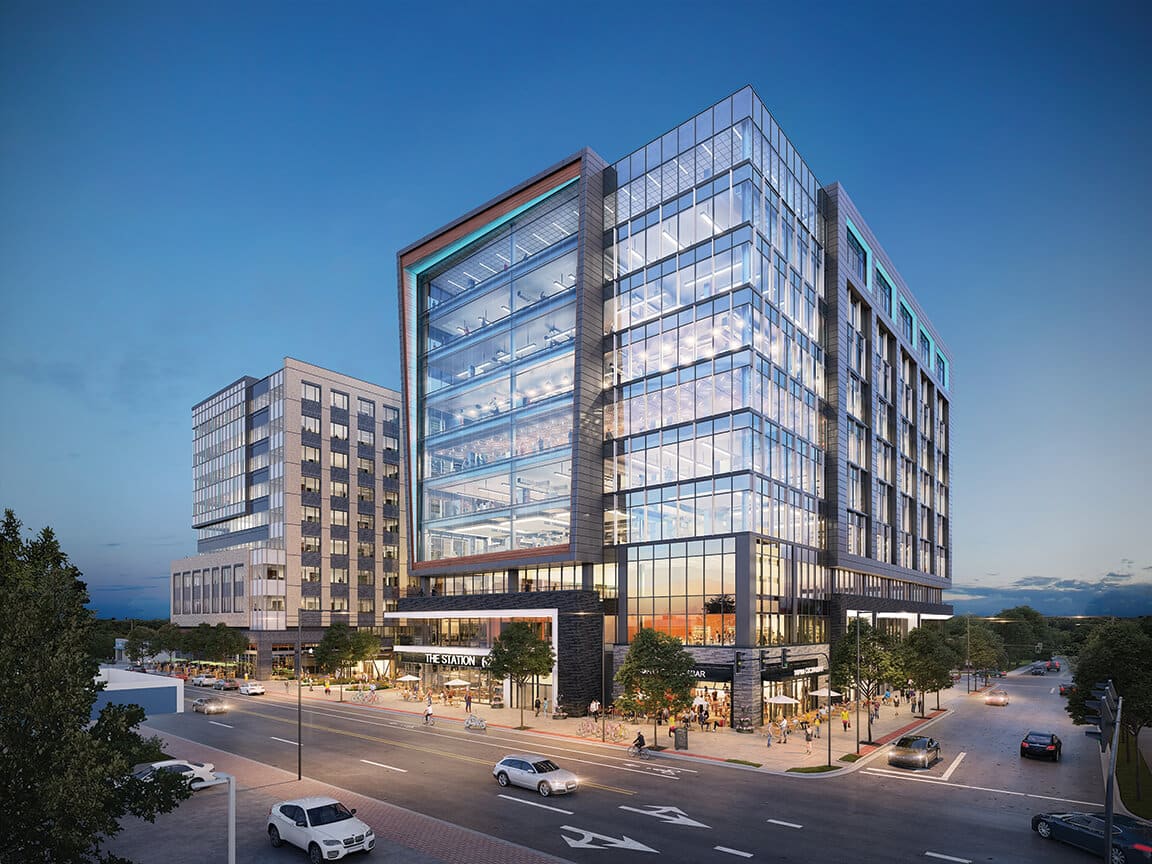Share this Post
Larry and Amy McBennett lived in their 1,900-square-foot home, built in 1940, in Raleigh’s Anderson Heights neighborhood for a decade. When the couple decided to sell the charming one-story house with the stone exterior and prominent chimney at 2705 Hazelwood Drive two years ago, they faced a dilemma. “We felt strongly that the facade was beautiful and fit nicely in the neighborhood,” Larry McBennett says. “We were aware that in the pricier neighborhoods in Raleigh, a lot of houses are being torn down and large McMansions are put up in their place. We knew that was a strong possibility for our lot. We did not want that to happen because it would be inconsiderate to our neighbors. And we wanted to preserve the house.”
The couple’s realtor, Randy Scherr, introduced them to Greg Hennis, a builder and the owner of GJH Construction. Hennis promised to preserve the home’s modest facade, original front rooms and masonry fireplace while expanding the house’s footprint up and out the back on the quarter-acre lot. In other words, he’d add the living space of a mansion without the ostentatious frontage or encroaching on neighboring lots, thereby preserving the home’s integrity as well as the neighborhood’s character.
“Within a handshake, we sold it to [Hennis] and he decided everything about the expansion,” McBennett says. “He did a spectacular job.” The house, now 5,455 square feet with oak floors, shiplap walls and plenty of natural light from tall, double hung windows, looks the same as before from the street in terms of its scale. But inside, there’s open space galore with a sprawling, all-new kitchen/family room, a first floor master suite, three upstairs bedrooms, a bonus room and dozens of cabinets, closets and functional nooks and crannies.
Crown molding, recessed lights and a spacious, stained pine screened-in porch profess a meticulous attention to detail. Most importantly, though, the neighbors are pleased. “We had our first open house right after we finished,” says Scherr, the realtor. “I had more people come through than any open house I’ve ever had before, and 80 percent of them were neighbors. They all just wanted to see it and the neighbors were enthralled. They all complimented us for keeping the integrity.”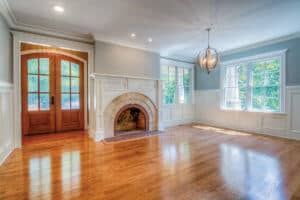
The Hazelwood expansion epitomizes—and offers a solution to—the ongoing struggle that’s been playing out in older Raleigh neighborhoods for years due to the area’s explosive growth: longtime residents want to preserve the character of homes and neighborhoods they’ve long admired, lived in and loved, while a new crop of buyers want big homes inside the Beltline that they’re willing to pay top dollar for. In many cases, the resulting teardowns give rise to large homes on small lots, stirring up tensions and creating more than a little friction between neighbors. But with consideration and thoughtful design, compromise is possible, as the McBennetts’ story shows.
“My wife and I have strong feelings about neighborhoods being harmonious places to live,” McBennett says. “We both grew up in eastern North Carolina, in neighborhoods where people knew each other; there was a lot of interaction among families, and people were considerate of each other.”
Raleigh’s origins date back to the mid-eighteenth century, and it was designated North Carolina’s capital in 1788. Some of its neighborhoods, including Historic Oakwood and Mordecai near downtown, are almost as old, featuring original homes built as far back as the mid-1850s.
Most of the city’s neighborhoods inside the Interstate 440 Beltline were developed between 1900 and 1950. After the Second World War, as in many U.S. cities, residents flocked to the suburbs, giving rise to the development of large subdivisions on hundreds of thousands of acres of land. Today, most of the city’s population of roughly 460,000—more than 230,000 people—live in the northern part of the city, in neighborhoods such as Wakefield, Bedford at Falls River and Brier Creek. The Raleigh-Cary metro area currently has a population of 1.3 million and, in the next 25 years, it’s expected to nearly double in size, with 2.2 million residents by 2040. It’s not hard to see why.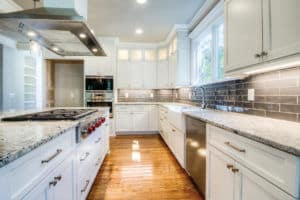
Recently, financial services web site Magnify Money ranked Raleigh fourth on a list of the 50 largest U.S. metros for a balanced lifestyle. The site considered factors such as average commute time, proportion of income spent on housing, earnings versus time spent working, local income equality, health and sleep, and prices for goods and services compared to the national average. While the study found that Raleigh’s percentage of median income that goes to cover the median housing costs was pretty middle-of-the-road at 20 percent, people are already feeling the crunch of a dwindling affordable housing supply on the ground. With few lots available within city limits to build new housing and only a few areas left where housing is truly affordable—the area east of downtown near St. Augustine’s University is one—more and more people are moving to the northern and southernmost edges of Wake and to neighboring counties where housing is cheaper and more abundant.
In the following pages, we take an in-depth look at where Raleigh lives now, with a sampling of ten neighborhoods we feel are representative of the city. These neighborhoods comprise both old and new and are located both inside the Beltline and out. If you’re looking to buy, we have some suggestions—including 2705 Hazelwood Drive, which will host an open house on March 10 from 1—4 p.m. If you’re looking to sell, you’re in luck because it’s a seller’s market at the moment. Know that you have options if you don’t want your home to become another tear down. And finally, if you’re looking just to look, we hope you’ll learn something new. As they say in the real estate business, it’s location, location, location. Right now, Raleigh’s it.
Bedford at Falls River
Located in northwest Raleigh and developed in 2001 on 600 acres of hills bordered by the Neuse River, Bedford at Falls River is one of the city’s newest neighborhoods. The community, which is split into several individual subdivisions featuring different styles of homes at various price points, features a recreation center, two swimming pools, playgrounds, tennis and volleyball courts, and more than 200 acres of parks, greenways and open space. A central Town Square functions as a gathering space for neighbors and features an iconic clock tower.
Median ListingPrice:
$347K
Price per SquareFoot:
$136
Cameron Park/ Cameron Village
Developed in 1910 on land that was formerly part of the Duncan Cameron Plantation, Cameron Park is bordered by Broughton High School, Saint Mary’s School, Pullen Park and Cameron Village. The neighborhood features various architectural styles and sizes, including bungalows, Colonial revivals, Modernist homes and duplexes, all close to downtown and to NC State University. The homes in Cameron Village, scattered all around the Cameron Village Shopping Center, are comprised of 1950s ranch style houses, townhouses and luxury condos and apartments. Development of the area began during the late 1940s.
Median Listing Price:
$600K (Cameron Park); $535K (Cameron Village)
Price per Square Foot:
$284 (Cameron Park); $240 (Cameron Village)
Brier Creek
Brier Creek is located near the intersection of I-540 and GlenwoodAvenue in northwest Raleigh, a 2,000-acre subdivision of single-family homes both modest and mansion-sized, luxury condos, businesses and shopping centers featuring big box stores. Centrally situated between downtown Raleigh and the Research Triangle Park, and adjacent to RDU Airport, Brier Creek features a country club neighborhood with an 18-hole golf course, a country club, tennis pavilionand a fitness center with an Olympic-size swimming pool.
Median Listing Price:
$307K (Brier Creek Country Club);
$529K (Regency at Brier Creek)
Price per Square Foot:
$149 (BCC); $202 (Regency)
Downtown Raleigh
Bordered by Peace Street to the north and Martin Luther King Jr. Boulevardto the south, the downtown Raleigh housing market largely consists of high-rise, luxury apartments and condos, townhouses and loft developments, all located within walking distance of downtown’s businesses, restaurants, government buildings and nightlife. Most of downtown’s housing was built in the last decade, including complexes such as SkyHouse on South Blount Street, the Hue and the Dawson in the Warehouse District and the Quorum, the Link and 222 Glenwood around Glenwood South. Other buildings are conversions, such as the Hudson on Fayetteville Street, formerly the city’s Belk department store when the street was a pedestrian mall.
Median Listing Price:
$369K
Price per Square Foot:
$273
Five Points/ Glenwood/ Hayes-Barton
Five Points is a central area comprised of shops, restaurants and businesses at the intersection of Glenwood Avenue, Fairview and Whitaker Mill Roads, with fuzzily defined borders and neighborhoods including Hayes Barton, Bloomsbury, Georgetown and Roanoke Park. Hayes Barton is one of the larger neighborhoods located inside the Beltline, developed after the First World War and characterized by bungalows and grand homes with large front porches. The Glenwood neighborhood stretches north from Peace Street to Wade Avenue, and includes the Glenwood-Brooklyn Historic District, with cottages and bungalows from the 1890s to the early 1900s.
Median Listing Price:
$475K (Five Points); $560K (Glenwood); $965K (Hayes Barton)
Price per Square Foot:
$242(Five Points); $214 (Glenwood); $242 (Hayes Barton)
Historic Oakwood
Located northeast of downtown, Oakwood arose after the Civil War as parcels of a dense woods known as “Mordecai Grove” were sold off and developed. Today, the city’s only intact nineteenth century neighborhood features homes dating back to the 1850s to a few contemporary homes built in the Modernist style. The majority of the neighborhood’s hundreds of homes feature historic architecture from the Civil War-era Neo-Classical styles, to Victorian Queen Annes and French Second Empire-inspired houses. The City of Raleigh designated Oakwood as the city’s first “local historic district” in 1974, with the intention of preserving the neighborhood’s charming homes and unique character.
Median Listing Price:
$395K
Price per Square Foot:
$277
North Ridge
Located off Falls of the Neuse Road in north Raleigh, North Ridge is sandwiched between the Beltline and I-540, on 750 rolling acres. The golf and country club community was developed in the 1970s and features large, single-family homes ranging from 2,000 to 6,000 square feet. Ranch homes, arts and crafts styles and two-story houses with French and English accented features are common in North Ridge, and the community offers two 18-hole golf courses, tennis courts, a fitness center, swimming pools and a clubhouse.
Median Listing Price:
$450K
Price per Square Foot:
$166
Mordecai
Raleigh’s oldest neighborhood, located north of downtown, Mordecai is named for the plantation on which is was developed in the 1700s. Today, the Mordecai House—built around 1785—is the city’s oldest house still standing in its original location. The compact, historically protected neighborhood features a historic park and several other historic buildings, including the Pilot Mill cotton mill established in 1892. Mordecai’s 200 or so homes mostly were built on deep lots following the First World War. The neighborhood is accessible via Person Street, a booming business district with lots of locally-owned shops and restaurants, and it’s adjacent to Seaboard Station and William Peace University.
Median Listing Price:
$498K
Price per Square Foot:
$250
North Hills
Raleigh’s fastest-growing neighborhood located off of I-440 consists of subdivisions anchored by The Circle at North Hills Shopping Center between Six Forks and Lassiter Mill Road. “Midtown,” as it’s known, is a gateway from downtown and older Raleigh neighborhoods inside the Beltline to the newer subdivisions in the northern part of the city. While development of the area began in the 1960s with ranch homes surrounding the regional shopping mall, North Hills looks a little different these days. High rise buildings and luxury condos as well as an open-air shopping center are centrally located, while surrounding neighborhoods such as Ramblewood feature townhouses and apartments. The Cardinal at North Hills, an upscale retirement community, opened recently off of St. Albans Drive.
Median Listing Price:
$470K
Price per Square Foot:
$191
Stonehenge
Founded in 1977, the north Raleigh subdivision features nearly 1,400 homes, a range of modest single-family homes, townhouses, apartment complexes, shopping centers and retirement communities. Bordered by the Lake Lynn watershed to the west and bisected by Creedmoor Road, most of the homes and newer developments within Stonehenge are located inside the city limits, though there is an unincorporated section of the community. The Seven Oaks Swim and Racquet Club offers tennis courts and swimming pools.
Median ListingPrice:
$385K
Price per Square Foot:
$146
Share this Post


